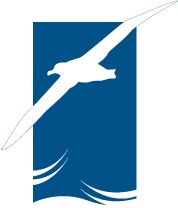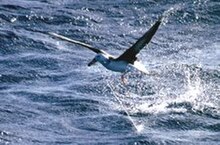Agreement on the Conservation of Albatrosses and Petrels
 Logo of the Conservation of Albatrosses and Petrels | |
| Abbreviation | ACAP |
|---|---|
| Formation | 1 February 2004 |
| Type | International organization |
| Purpose | Conservation |
| Location | |
| Coordinates | 42°53′00″S 147°19′45″E / 42.883394°S 147.329126°E |
Area served | International |
Membership | 13 state members |
Executive Secretary | Christine Bogle |
| Website | acap |

The Agreement on the Conservation of Albatrosses and Petrels (ACAP) is a legally binding international agreement signed in 2001 and entered into force on 1 February 2004 when South Africa ratified as the fifth Party to the Agreement.
It was created in order to halt the drastic decline of seabird populations in the Southern Hemisphere, particularly of albatrosses and petrels. Albatrosses and petrels are threatened by introduced species on their breeding islands, pollution, and by being taken as bycatch by longline fisheries, as well as by trawl and gillnet fisheries. The Agreement requires that measures be taken by signatory governments to reduce bycatch; protect breeding colonies; and control and remove introduced species from breeding sites, especially on islands.
Currently, ACAP protects all the world's albatross species, seven Southern Hemisphere petrel species and two shearwater species. The ongoing work of the Agreement reflects an increasing international commitment to protect albatrosses and petrels.
Organization
[edit]The Executive Secretary of ACAP is Christine Bogle, who is supported by a Science Officer, Wiesława Misiak, and an honorary Information Officer, John Cooper.[1] The Secretariat is located at 119 Macquarie Street, Hobart in the state of Tasmania, Australia.[2][3]
The Agreement entered into force on 1 February 2004. National representatives of the Parties meet regularly. Six Meetings of the Parties have been held. The seventh will be held in Australia during 2022.
| Location | Date |
|---|---|
| Hobart, Australia | 10-12 November 2004 |
| Christchurch, New Zealand | 13-17 November 2006 |
| Bergen, Norway | 27 April - 1 May 2009 |
| Lima, Peru | 23-27 April 2012 |
| Santa Cruz de Tenerife, Spain | 4-8 May 2015 |
| Skukuza, South Africa | 7-11 May 2018 |
Eleven meetings of ACAP's Advisory Committee have been held to date, the last in Florianópolis, Brazil from 13 to 17 May 2019. The Advisory Committee is currently supported by three working groups for Taxonomy, Seabird Bycatch, and Population and Conservation Status.
Meeting agendas, final reports and submitted documents and information papers may be downloaded from the Agreement's website at www.acap.aq.
Due to travel restrictions caused by the COVID-19 pandemic ACAP Parties have decided to postpone the next meeting of the Advisory Committee (AC12) and of its Working Groups (SBWG10 and PaCSWG6) to 2021, to be held in Ecuador.
The Agreement's activities are funded from a modest budget stemming mainly from assessed contributions by the Parties. As well as supporting the Secretariat and annual meetings, funds are used to support conservation activities, including the Small Grants and Secondment Programmes.
Provisions
[edit]ACAP helps countries to implement species action plans, control the expansion of non-native predators, introduce measures reducing bycatch of seabirds, and support research in the sphere of the effective conservation of petrels and albatrosses. To this end it has published ACAP Species Assessments, booklets, mitigation factsheets, and a number of ACAP Conservation Guidelines, including for biosecurity; eradication of introduced mammals; translocation; and census and survey methods.
One of the Agreement's main activities is to provide expert advice on seabird bycatch mitigation to fisheries managers, both in domestic and high seas fisheries.
In May 2019 the ACAP Advisory Committee declared that a conservation crisis continues to be faced by its 31 listed species, with thousands of albatrosses, petrels and shearwaters dying every year as a result of fisheries operations. To increase awareness of this crisis ACAP has inaugurated a World Albatross Day, to be held annually from 2020 on 19 June, the date the Agreement was signed in 2001.
Species covered by the Agreement
[edit]The following 31 species of albatrosses, petrels and shearwaters are listed by the Agreement.
- Albatrosses
- Northern Royal Albatross (Diomedea sanfordi)
- Southern Royal Albatross (Diomedea epomophora)
- Wandering Albatross (Diomedea exulans)
- Antipodean Albatross (Diomedea antipodensis)
- Amsterdam Albatross (Diomedea amsterdamensis)
- Tristan Albatross (Diomedea dabbenena)
- Sooty Albatross (Phoebetria fusca)
- Light-mantled Albatross (Phoebetria palpebrata)
- Waved Albatross (Phoebastria irrorata)
- Short-tailed Albatross (Phoebastria albatrus)
- Laysan Albatross (Phoebastria immutabilis)
- Black-footed Albatross (Phoebastria nigripes)
- Atlantic Yellow-nosed Albatross (Thalassarche chlororhynchos)
- Indian Yellow-nosed Albatross (Thalassarche carteri)
- Grey-headed Albatross (Thalassarche chrysostoma)
- Black-browed Albatross (Thalassarche melanophris)
- Campbell Albatross (Thalassarche impavida)
- Buller's Albatross (Thalassarche bulleri)
- Shy Albatross (Thalassarche cauta)
- White-capped Albatross (Thalassarche steadi)
- Chatham Albatross (Thalassarche eremita)
- Salvin's Albatross (Thalassarche salvini)
- Petrels and shearwaters
- Southern Giant Petrel (Macronectes giganteus)
- Northern Giant Petrel (Macronectes halli)
- White-chinned Petrel (Procellaria aequinoctialis)
- Spectacled Petrel (Procellaria conspicillata)
- Black Petrel (Procellaria parkinsoni)
- Westland Petrel (Procellaria westlandica)
- Grey Petrel (Procellaria cinerea)
- Balearic Shearwater (Puffinus mauretanicus)
- Pink-footed Shearwater (Ardenna creatopus)
Member states
[edit]The following 13 countries are Parties to the Agreement:
 Argentina
Argentina Australia
Australia Brazil
Brazil Chile
Chile Ecuador
Ecuador France
France New Zealand
New Zealand Norway
Norway Peru
Peru South Africa
South Africa Spain
Spain United Kingdom
United Kingdom Uruguay
Uruguay
Canada, Namibia and the United States of America regularly send observer delegations to ACAP meetings, but have not as yet acceded to the Agreement.[4] Japan and Mexico have sent delegations to meetings in some years. Chinese Taipei has attended as a member economy of the Asia Pacific Economic Forum. Any Range State or regional economic integration organisation may become a Party to the Agreement by accession. The term ‘Range State’ refers to a State with jurisdiction over any part of the range of albatrosses or petrels, or a State whose flag vessels are outside its national jurisdictional limits and either take or have the potential to take albatrosses and petrels.
Both international and national non-governmental organizations (NGOs) may apply to attend ACAP meetings as observers.
See also
[edit]References
[edit]- ^ "Agreement on the Conservation of Albatrosses and Petrels - ACAP Secretariat Staff". acap.aq. Retrieved 30 June 2017.
- ^ "Headquarters Agreement Between the Government of Australia and the Secretariat to the Agreement on the Conservation of Albatrosses and Petrels (Hobart, 23 June 2008) - ATS 19 of 2008”. Australasian Legal Information Institute, Australian Treaties Library. Retrieved on 18 April 2017.
- ^ "Agreement on the Conservation of Albatrosses and Petrels - Home". acap.aq. Retrieved 30 June 2017.
- ^ Williams, Ted (May 2016). "How Congress Can Protect Seabirds With One Simple Act". Audubon. Retrieved May 17, 2016.
External links
[edit]- Convention on the Conservation of Migratory Species of Wild Animals
- Procellariiformes
- Albatrosses
- Treaties concluded in 2001
- Treaties entered into force in 2004
- Bird conservation
- 2004 in the environment
- Treaties of Argentina
- Treaties of Australia
- Treaties of Brazil
- Treaties of Chile
- Treaties of Ecuador
- Treaties of France
- Treaties of New Zealand
- Treaties of Norway
- Treaties of Peru
- Treaties of South Africa
- Treaties of Spain
- Treaties of the United Kingdom
- Treaties of Uruguay
- Intergovernmental organizations established by treaty
- International organisations based in Argentina
